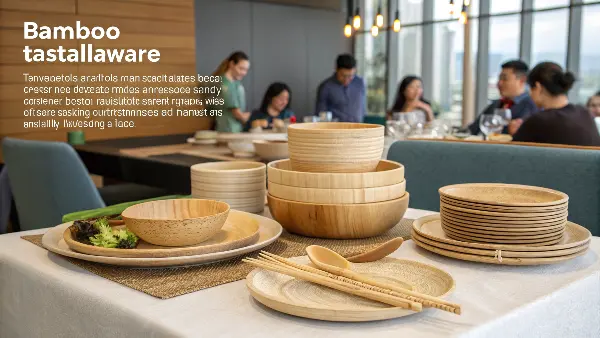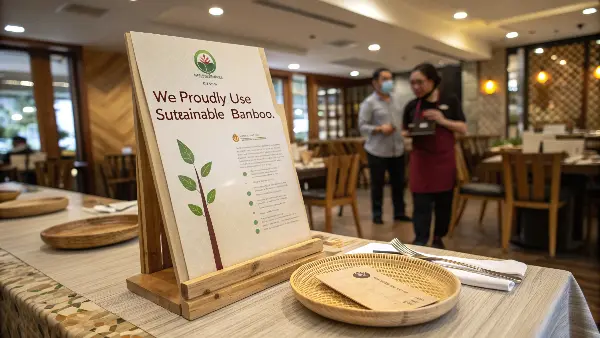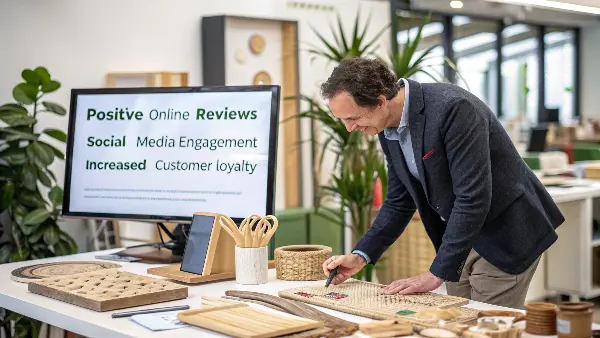Your restaurant wants to be seen as a leader in sustainability, but making a real impact feels complicated. You worry that your efforts might go unnoticed or be dismissed as "greenwashing." True sustainability needs to be tangible, something your customers can see and feel, turning your environmental commitment into a memorable part of their dining experience.
Bamboo tableware is a powerful tool for sustainability marketing because it offers a visible, physical symbol of your restaurant’s eco-conscious values. By highlighting its benefits—rapid renewability, biodegradability, and natural aesthetic—on menus, social media, and in-store displays, you can communicate your commitment transparently. This builds customer trust, differentiates your brand, and attracts diners who prioritize sustainability, turning a simple operational choice into a core marketing asset.

Simply switching your forks and plates is just the first step. The real magic happens when you weave this decision into the fabric of your brand’s story. It’s about transforming a behind-the-scenes purchase into a front-facing statement that resonates with every guest who walks through your door. Let’s dig into how you can make that happen.
Why is Bamboo the Secret Ingredient for Your Restaurant’s Eco-Story?
You need a sustainable option for your tableware that is both practical for your kitchen and compelling for your customers. Many so-called "eco-friendly" products can be flimsy, expensive, or come from questionable sources, creating more problems than they solve. Bamboo, however, provides a perfect blend of strength, style, and a powerful environmental narrative that’s easy for everyone to appreciate.
Bamboo is the secret ingredient for your eco-story because it is a grass, not a tree, making it a uniquely rapid renewable resource. It grows to maturity in just a few years without needing pesticides or extensive irrigation. Its products are sturdy, stylish, and fully biodegradable. This creates a simple but powerful story of positive environmental choice, turning a disposable item into a conversation starter and a key marketing tool.

Dive Deeper: The Tangible Benefits of Bamboo
Choosing bamboo goes far beyond a simple "green" label. It offers a multi-layered story that benefits the planet, your customers, and your operations. As a sourcing expert, I’ve seen clients transform their brand perception by focusing on these three core areas. It’s not just about what you avoid (plastic), but what you embrace.
The Environmental Edge of Bamboo
The environmental case for bamboo is incredibly strong and easy to communicate. Unlike trees that can take decades to mature, bamboo is one of the fastest-growing plants on Earth. This rapid growth cycle means it can be harvested sustainably without causing deforestation. It also plays a vital role in its ecosystem by releasing more oxygen and absorbing more carbon dioxide than a comparable stand of trees. When I work with partners like Jacky, a packaging specialist in Canada, we always emphasize that choosing FSC-certified bamboo ensures it comes from responsibly managed forests, protecting biodiversity and the local communities. This certification adds a layer of trust to your marketing claims.
The Customer Experience Factor
Customers don’t just eat with their mouths; they eat with their eyes and hands, too. Bamboo tableware has a natural, warm aesthetic that plastic or even bleached paper products can’t match. It communicates quality and care. It’s also surprisingly strong and durable, preventing the frustrating snaps of a flimsy plastic fork. I once worked with a coastal bistro that switched to bamboo cutlery for their takeout service. They told me customer complaints about broken utensils dropped to zero, and they started receiving positive reviews specifically mentioning the "lovely wooden cutlery." That’s a direct, tangible improvement to the customer experience.
Operational Advantages for Your Restaurant
From a business standpoint, bamboo makes sense. It is lightweight, which can reduce shipping costs, and it is heat-resistant and cut-resistant, making it suitable for a wide variety of hot and cold dishes. Here’s a quick comparison to show where it stands:
| Feature | Bamboo Tableware | PLA (Corn-based) Tableware | Paper Tableware |
|---|---|---|---|
| Source | Rapidly renewable grass | Renewable crops | Trees or recycled paper |
| Feel & Strength | Strong, natural, premium | Plastic-like, can be brittle | Can get soggy, low strength |
| Heat Resistance | Good for hot foods | Poor (melts at low temps) | Variable, often needs coating |
| Marketing Story | Easy to understand, natural | Technical, "bioplastic" | Common, less unique |
| End-of-Life | Commercially compostable | Commercially compostable | Compostable/Recyclable |
This table clearly shows that bamboo offers a balanced profile of performance, sustainability, and marketability that is hard to beat.
How Can You Weave Bamboo into Your Restaurant’s Marketing Narrative?
You’ve made the investment in high-quality bamboo tableware, but are your customers actually noticing? If you don’t actively share the "why" behind your choice, you’re missing the biggest opportunity. Your sustainability efforts risk becoming an invisible operational cost instead of a powerful, brand-building asset that connects with your diners. You can change this by strategically integrating your bamboo story into every customer touchpoint.
Weave bamboo into your marketing narrative by making it a visible and consistent message. Add a small leaf icon or a note on your menu that says, "We proudly use sustainable bamboo." Create simple table tents that explain the benefits. Share a post on social media about your commitment. Most importantly, empower your staff to speak knowledgeably about it. This turns a product into an ongoing, authentic conversation with your customers.

Dive Deeper: Activating Your Sustainability Story
Your story isn’t just a single announcement; it’s a continuous conversation. To make it effective, you need to embed it across your physical and digital presence. The goal is to make your commitment impossible to miss but easy to digest. I’ve helped countless B2B clients guide their own restaurant partners through this process, and success always comes down to a multi-channel approach.
On-Site Messaging: Turn Your Space into a Story
Your restaurant itself is your most powerful marketing tool. Use it to tell your bamboo story.
- Menu Mentions: A short, sweet line at the bottom of your menu or a small symbol next to certain items is a great start. Something like, "To protect our planet, our disposable tableware is made from 100% sustainable bamboo."
- Table Tents or Small Cards: A dedicated card on each table can provide more detail in a bite-sized format. Use a QR code that links to a sustainability page on your website where customers can learn more if they are interested. This strategy worked wonders for a cafe chain in Europe we supply; they reported a 15% increase in positive social media mentions after introducing the QR code cards.
- Visual Cues: Don’t hide your beautiful bamboo products. If you have an open kitchen or counter service, display them neatly. Visibility reinforces the message.
Digital Storytelling: Go Beyond the Restaurant Walls
Your digital presence is where you can build a deeper connection with your audience.
- Social Media: Go beyond a single post. Create a short video showing why you chose bamboo. Run an Instagram poll asking your followers what sustainability means to them. Share facts about bamboo’s benefits. User-generated content is also powerful; encourage customers to post photos with a specific #hashtag celebrating your green choice.
- Your Website: Dedicate a page to your sustainability journey. This is where you can go into detail about your sourcing, certifications (like FSC), and your partnership with a trusted supplier like Ecosourcecn. Transparency builds immense trust.
- Email Newsletters: Include a section in your regular newsletters about your green initiatives. It reminds your loyal customer base that you are a brand that shares their values.
Staff as Sustainability Ambassadors
Your team is your front line. Answering "Why do you use these wooden forks?" with "I don’t know" is a massive missed opportunity. A simple training session can turn your staff into enthusiastic advocates. Give them three key points to remember about why the restaurant chose bamboo. When a customer asks, a confident and knowledgeable answer makes your commitment feel genuine and deep-rooted.
How Do You Choose the Right Bamboo Products and Measure Your Green ROI?
You’re ready to commit to bamboo, but the market is flooded with options and suppliers. How do you know who to trust? Choosing the wrong partner can lead to receiving low-quality products that break easily, facing inconsistent supply during peak season, or even unknowingly engaging in greenwashing if the products aren’t genuinely compostable or sustainably sourced. A strategic approach to sourcing and measurement protects your investment and your brand’s integrity.
To choose the right bamboo products, partner with a supplier who provides full transparency and internationally recognized certifications like FSC, FDA, and LFGB. To measure your Green ROI, look beyond the initial cost. Track metrics like positive online reviews mentioning sustainability, social media engagement on your eco-content, increased customer loyalty, and improved staff morale. This ROI is measured in brand value and customer trust.

Dive Deeper: Sourcing with Confidence and Measuring What Matters
For a professional like Jacky, the packaging specialist, this is the most critical stage. Making the right choice here ensures the entire sustainability strategy is built on a solid foundation. It’s about moving from a simple purchase to a strategic partnership. Over the years, I’ve developed a checklist to help my clients navigate this process.
The Supplier Checklist: Your Non-Negotiables
Don’t compromise on these fundamentals. A good partner will be happy to provide this information.
| Checklist Item | Why It Matters | What to Ask For |
|---|---|---|
| Certifications | Proves products meet safety, quality, and environmental standards. | Ask for copies of FSC, BRC, FDA, LFGB, and compostability (EN13432/ASTM D6400) certs. |
| Supply Chain Transparency | Ensures ethical and sustainable sourcing from forest to factory. | Ask where the bamboo is grown and how they ensure responsible harvesting. |
| Quality Control | Guarantees product consistency and performance (no splinters, weak spots). | Request their QC process documentation and ask for product samples to test yourself. |
| Logistics & Scalability | Confirms they can deliver on time and meet your volume needs as you grow. | Discuss lead times, shipping options, and their experience supplying your region. |
| Customization | Allows you to add your brand logo for enhanced marketing. | Ask about private label or custom branding capabilities and minimum order quantities. |
Measuring Your "Return on Integrity"
The ROI of sustainability isn’t always found on a spreadsheet. You need to look for value in different places.
- Quantitative Metrics:
- Track the number of positive reviews on Google, Yelp, etc., that specifically mention "eco-friendly," "sustainable," or "bamboo."
- Measure likes, shares, and comments on social media posts related to your green initiatives.
- Survey customers to see if your sustainability efforts influence their decision to return.
- Qualitative Metrics:
- Brand Perception: Are you becoming known as the "green" cafe in your neighborhood? This is powerful word-of-mouth marketing.
- Customer Loyalty: Eco-conscious consumers are fiercely loyal to brands that share their values.
- Employee Pride: Staff feel better about working for a company that does the right thing. This can reduce turnover and attract better talent. I have a client who told me their best new hires mentioned the company’s public commitment to sustainability as a key reason they applied. That’s a powerful and often overlooked benefit.
Conclusion
Switching to bamboo tableware is more than an operational change; it’s a powerful marketing move. By choosing a high-quality product from a trusted partner, telling your story authentically across all channels, and understanding its value beyond just cost, you can build a stronger, more resilient brand that customers genuinely want to support.


